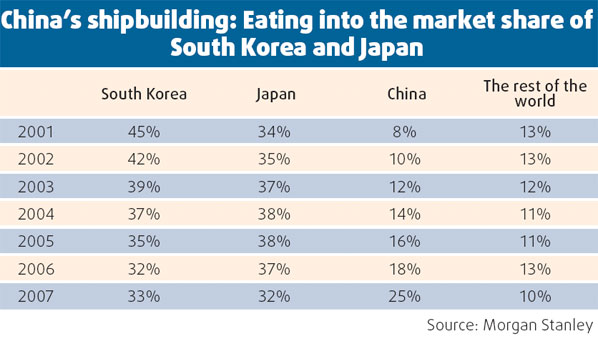
|
BIZCHINA> Center
 |
|
Shipbuilders grab more global market
(China Daily)
Updated: 2008-04-28 10:02 Success factors Researchers studying the Japanese and the South Korean shipbuilding industries suggest there are several factors that a growing market leader must have. The role of the government is very important with subsidies and general support and China's shipbuilding sector has enjoyed strong government support. In 2006, the State Council approved the long-term blueprint for the industry which set a target for the industry to comprise at least 25 percent of the world's total output by 2010 and 35 percent in 2015. But the development is better-than-expected. To power the goal, the Chinese government has already implemented several favorable policies to boost the sector's growth, including giving financial support by awarding special loans to shipbuilders and giving them preferential interest rates. In terms of technology, Chinese shipbuilders are also catching up with the South Korea and Japan. In 2005, the Hudong Zhonghua shipyard built the first LNG carrier in China. In 2007, China State Shipbuilding Corp delivered the first 8,530 TEU container ship, while Waigaoqiao shipyard delivered a 300,000 deadweight tonnage oil tanker. Industry observers expect a continuous upgrade of product mix with more high-end vessels being built. "We believe Chinese shipbuilders will become more competitive," says Hu. China will fully catch up in technology in a few years, he adds. China's shipbuilders also enjoy cheap labor costs, of course. The cost of shipbuilding in Japan and South Korea is 30-40 per cent higher than that of China, which makes China more competitive in the market. Challenges The key is to improve the industry's efficiency and productivity, say analysts. The efficiency of the country is about half of that of Japan and South Korea. Among the problems still plaguing the industry are: The ship design and supply chain are major bottlenecks and there is less cooperation among the country's shipbuilders which leads a slow diffusion of the technologies within the industry; Many older shipyards are not designed to follow the most-rational manufacturing process. The industry is slow to adapt new eco-friendly methods as manufacturers fear cost will rise. And the appreciation of the yuan is a potential threat due to weaker the industry's weaker earning capabilities. The situation also points to the industry's vulnerability to market and raw supply fluctuations. "The biggest challenge is how Chinese shipyards can improve their competitiveness," Hu says.
 (For more biz stories, please visit Industries)
|